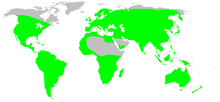Chigger
| Chigger | |
|---|---|

| |
| Trombiculid mite larva | |
| Scientific classification | |
| Domain: | Eukaryota |
| Kingdom: | Animalia |
| Phylum: | Arthropoda |
| Subphylum: | Chelicerata |
| Class: | Arachnida |
| Subclass: | Acari |
| Order: | Trombidiformes |
| Superfamily: | Trombidioidea |
| Family: | Trombiculidae Ewing, 1929[1] |
| Type species | |
| Trombicula autumnalis (Shaw, 1790)
| |
| Genera[2] | |
| |

| |
| The distribution of trombiculid species, which is nearly everywhere in the world. | |

A chigger is a small, parasitic mite which lives in tall grass.[3][4] It is a member of a larger family known as the Trombiculidae.
The species of Trombiculidae which bite in their larval stage cause "intense irritation",[5] or "a wheal, usually with severe itching and dermatitis".[6][7]
Their color can range from bright red to brown. Chiggers are almost too small to see with the naked eye, so checking grass for them is near impossible. Chigger bites appear 2-3 hours after a host is bitten, and can last for a few weeks. They bite in hot, moist places, such as the armpits, under the knees, and the genitals.
Trombiculidae live in forests and grasslands and in low, damp areas such as woodlands, berry bushes, orchards, along lakes and streams. It does live in drier places, such as lawns, golf courses, and parks.[8] They are most numerous in early summer when grass, weeds, and other vegetation are heaviest.
In their larval stage they attach to various animals and feed on skin, often causing itching.[9][10]
The best known species of chigger in North America is the hard-biting Trombicula alfreddugesi of the southeastern United States, humid midwest and Mexico.[11][12] In the UK, the most common chigger, the "harvest mite", is Trombicula autumnalis. It lives through Western Europe to Eastern Asia.[13]
References
[change | change source]- ↑ "Trombiculidae Ewing, 1929 (Family)". SysTax - database query. Universität Ulm. Archived from the original on 2017-06-21. Retrieved 2009-03-06.
- ↑ Shatrov, Andrey B.; Kudryashova, Naina I. (2008). "Taxonomic ranking of major trombiculid subtaxa with remarks on the evolution of host-parasite relationships (Acariformes: Parasitengona: Trombiculidae)". Annales Zoologici. 58 (2): 279–287. doi:10.3161/000345408X326591. S2CID 83569187.
- ↑ Smith G.A. et al. 1998 (1998). "The summer penile syndrome: seasonal acute hypersensitivity reaction caused by chigger bites on the penis". Pediatric Emergency Care. 14 (2): 116–118. doi:10.1097/00006565-199804000-00007. PMID 9583392. S2CID 37926004.
{{cite journal}}: CS1 maint: numeric names: authors list (link) - ↑ Medical Definition from Merriam-Webster, Chigger, 2; "...and causes intense irritation" Retrieved March 7, 2014
- ↑ Merriam-Webster's Online Dictionary, chiggers cause intense irritation
- ↑ chigger: Medical dictionary: "produces a wheal, usually with severe itching and dermatitis"
- ↑ Chigger: Archived 2012-09-26 at the Wayback Machine American Heritage Dictionary
- ↑ Ballantine, Todd (1991). Tideland treasure: the naturalist's guide to the beaches and salt marshes of Hilton Head Island and the southeastern coast. Columbia, South Carolina: University of South Carolina Press. pp. 1–4. ISBN 0-87249-795-X.
- ↑ Mandell, Gerald L; Bennett J.E. & Dolin R 2005. Principles and practice of infectious diseases. Philadelphia: 6th ed, Elsevier Churchill Livingstone. ISBN 978-0-443-08686-1.
{{cite book}}: CS1 maint: multiple names: authors list (link) CS1 maint: numeric names: authors list (link) - ↑ Goldman, Lee & Ausiello, Dennis Arthur 2007. Cecil Medicine. Elsevier Health Sciences, p1032.
{{cite book}}: CS1 maint: multiple names: authors list (link) CS1 maint: numeric names: authors list (link) - ↑ Eutrombicula (Trombicula) alfreddugesi is the most familiar [chigger] in North America".
- ↑ "Eutrombicula alfreddugesi". "...from the Atlantic coast to the Midwest and southward..." Encyclopædia Britannica Online, 2011. Web. 10 Aug. 2011.
- ↑ N. autumnalis "has not been found in the Nearctic region...." http://www.vetstream.com/lapis/Content/Bug/bug00357 Archived 2012-03-22 at the Wayback Machine
